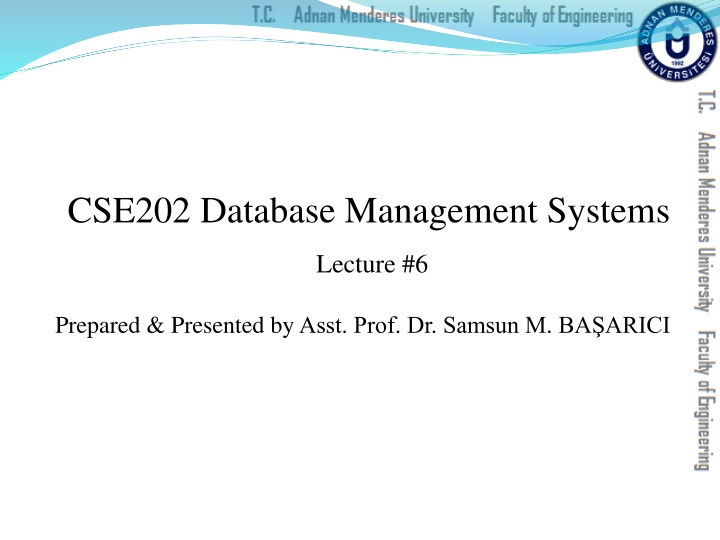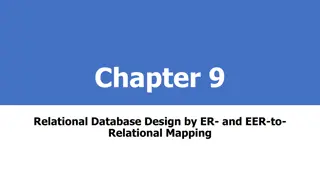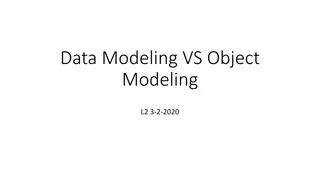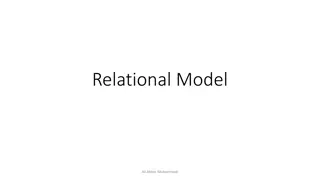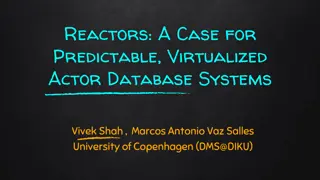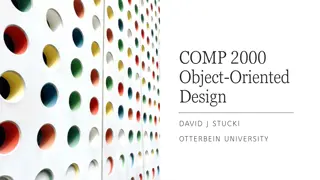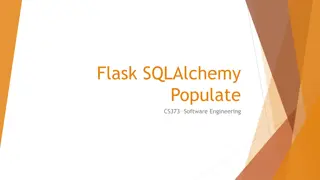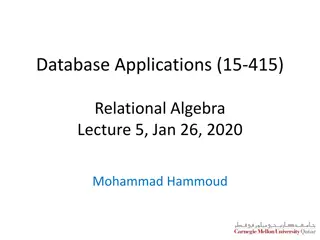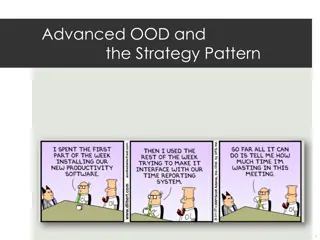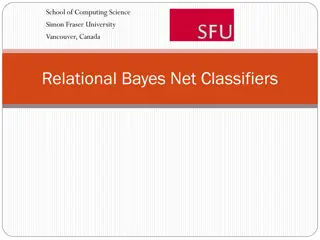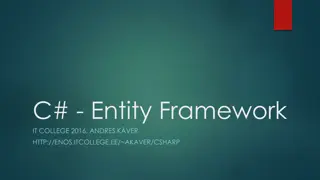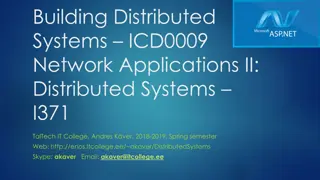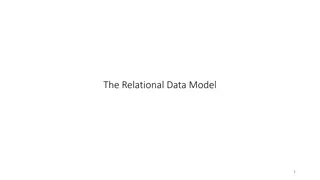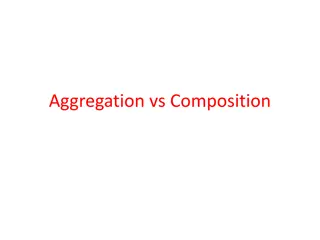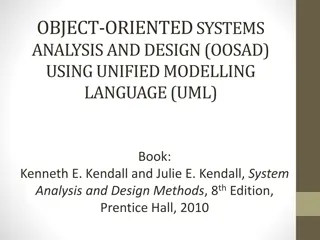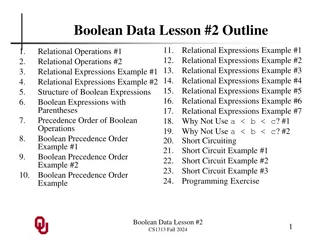Object-Oriented Database Concepts and Limitations in Relational Models
Object-oriented database concepts are introduced as an alternative to relational models, addressing limitations such as lack of support for complex data structures, generalization, specialization, and aggregation. The shift towards a more data-centric approach in information systems development is discussed, highlighting the benefits of encapsulation and abstract data types.
Download Presentation

Please find below an Image/Link to download the presentation.
The content on the website is provided AS IS for your information and personal use only. It may not be sold, licensed, or shared on other websites without obtaining consent from the author.If you encounter any issues during the download, it is possible that the publisher has removed the file from their server.
You are allowed to download the files provided on this website for personal or commercial use, subject to the condition that they are used lawfully. All files are the property of their respective owners.
The content on the website is provided AS IS for your information and personal use only. It may not be sold, licensed, or shared on other websites without obtaining consent from the author.
E N D
Presentation Transcript
CSE202 Database Management Systems Lecture #6 Prepared & Presented byAsst. Prof. Dr. Samsun M. BA ARICI
Learning Objectives List several limitations in the relational database model. Describe the object-oriented database concept. Model data using such complex relationships as generalization and aggregation, and such concepts as inheritance and polymorphism. Describe the benefits of encapsulation. Describe the value of developing abstract data types. Explain what an object/relational database is. 2
Outline Overview of Object Database Concepts Object-Relational Features: Object Database Extensions to SQL The ODMG Object Model and the Object Definition Language ODL Object Database Conceptual Design The Object Query Language OQL Overview of the C++ Language Binding in the ODMG Standard 3
Historically Speaking For much of IS history the emphasis was on the programs, with the data structures and ultimately the data stored in them being a secondary consideration. The IS environment is changing from this program-centric mentality into a more data-centric one. 4
Object Orientation An alternative approach to information systems and IS development. Began during the 1980s. More data-centric. 5
Whats Missing in the Relational Database Concept? Many people would say that nothing is missing from the relational model. Others would point out that for certain kinds of complex applications, the relational model is lacking in support for the more complex data model features they need. 6
Whats Missing in the Relational Database Concept? Does not directly provide support for generalization/specialization. Does not directly provide support for aggregation. 7
Whats Missing in the Relational Database Concept? Does not have a system in which only a limited, controlled set of program segments is allowed to update particular data. Does not directly support more complex data types such as: graphic images photo images video clips audio clips long text documents mathematical constructs such as matrices 8
Terminology: Object-Oriented Data Modeling Object - describes an advanced data structure that includes an entity s attributes plus methods or operations or procedures (program code!) that can operate on and modify the object s attribute values. (object) class - the objects that describe similar entities. 9
More advantages of Object Oriented Database Concept Each object has an object identifier that is permanent and unique among all objects of all types in the system. Some OODBMSs are implemented as pointer-based systems. related objects are connected by their storage addresses. OODBMSs are the most natural data storage vehicles when object-oriented programming languages, such as C++, Smalltalk, and Java, are in use. 10
Unified Modeling Language Introduced in 1997 by the Object Management Group (OMG) Has nine standard diagrams that describe: the system s data the business processes the intended results the components of the program code the hardware and software architectures. 11
UML Class Diagram Describes the system s data, including attributes of and relationships between the objects. 12
Object and Object-Relational Databases Object databases (ODB) Object data management systems (ODMS) Meet some of the needs of more complex applications Specify: Structure of complex objects Operations that can be applied to these objects 13
Overview of Object Database Concepts Introduction to object-oriented concepts and features Origins in OO programming languages Object has two components: State (value) and behavior (operations) Instance variables Hold values that define internal state of object Operation is defined in two parts: Signature or interface and implementation 14
Overview of Object Database Concepts (contd.) Inheritance Permits specification of new types or classes that inherit much of their structure and/or operations from previously defined types or classes Operator overloading Operation s ability to be applied to different types of objects Operation name may refer to several distinct implementations 15
Object Identity, and Objects versus Literals Unique identity Implemented via a unique, system-generated object identifier (OID) Immutable Most OO database systems allow for the representation of both objects and literals (or values) 16
Complex Type Structures for Objects and Literals Structure of arbitrary complexity Contain all necessary information that describes object or literal Nesting type constructors Construct complex type from other types Most basic constructors: Atom Struct (or tuple) Collection 17
Complex Type Structures for Objects and Literals (cont.) Collection types: Set Bag List Array Dictionary Object definition language (ODL) Used to define object types for a particular database application 18
Generalization Also known as generalization/specialization Is a relationship that recognizes that some kinds of entities can be subdivided into smaller, more specialized groups. 20
General Hardware Company ERD General Hardware company E-R diagram. General Hardware is a wholesaler. 10-21
General Hardware Company Generalization Diagram Each box represents a class and has three sections separated by horizontal lines. At the top, in capital letters, is the class name In the middle are the class attributes At the bottom are the class operations (not shown) 10-22
General Hardware Company Generalization Diagram (cont.) The upward pointing arrows indicate generalizations. There are three kinds of products TOOLs LIGHT FIXTUREs LUMBER There are two kinds of tools POWER TOOLs NONPOWER TOOLs 10-23
Encapsulation of Operations and Persistence of Objects Encapsulation Related to abstract data types and information hiding in programming languages Define behavior of a type of object based on operations that can be externally applied External users only aware of interface of the operations Divide structure of object into visible and hidden attributes 24
Encapsulation of Operations Object constructor Used to create a new object Destructor operation Used to destroy (delete) an object Modifier operations Modify the states (values) of various attributes of an object Retrieve information about the object Dot notation used to apply operations to object 25
Persistence of Objects Transient objects Exist in executing program Disappear once program terminates Persistent objects Stored in database and persist after program termination Naming mechanism Reachability 26
Type Hierarchies and Inheritance Inheritance Definition of new types based on other predefined types Leads to type (or class) hierarchy Type: type name and list of visible (public) functions Format: TYPE_NAME: function, function, ..., function 27
Type Hierarchies and Inheritance (cont.) Subtype Useful when creating a new type that is similar but not identical to an already defined type Example: EMPLOYEE subtype-of PERSON: Salary, Hire_date, Seniority STUDENT subtype-of PERSON: Major, Gpa 28
Type Hierarchies and Inheritance (cont.) Extent Store collection of persistent objects for each type or subtype Extents are subsets of the extent of class OBJECT Persistent collection Stored permanently in the database Transient collection Exists temporarily during the execution of a program 29
Other Object-Oriented Concepts Polymorphism of operations Also known as operator overloading Allows same operator name or symbol to be bound to two or more different implementations Depending on type of objects to which operator is applied Multiple inheritance Subtype inherits functions (attributes and methods) of more than one supertype Selective inheritance Subtype inherits only some of the functions of a supertype 30
Summary of Object Database Concepts Object identity Type constructor Encapsulation of operations Programming language compatibility Type hierarchies and inheritance Extents Polymorphism and operator overloading 31
Object-Relational Features: Object Database Extensions to SQL Type constructors Specify complex objects Mechanism for specifying object identity Encapsulation of operations Provided through user-defined types (UDTs) Inheritance mechanisms Provided using keyword UNDER 32
Object/Relational Database OODBMSs were lacking in several areas, including the superior query capabilities of SQL that everyone had become accustomed to. Relational database and object-oriented database have come together in the form of hybrid relational database management systems with object-oriented features added to them. 33
User-Defined Types and Complex Structures for Objects UDT syntax: CREATE TYPE TYPE_NAME AS (<component declarations>); ROW TYPE Directly create a structured attribute using the keyword ROW 34
User-Defined Types and Complex Structures for Objects (cont d.) Array type Reference elements using [] CARDINALITY function Return the current number of elements in an array 35
Object Identifiers Using Reference Types Reference type Create unique system-generated object identifiers Examples: REF IS SYSTEM GENERATED REF IS <OID_ATTRIBUTE> <VALUE_GENERATION_METHOD> ; 36
Creating Tables Based on the UDTs INSTANTIABLE Specify that UDT is instantiable Causes one or more tables to be created 37
Inheritance of Attributes The PRODUCT class indicates that all products have three common attributes: Product Number, Product Name, and Unit Price. All of the classes below PRODUCT inherit the attributes shown in PRODUCT. 10-38
Inheritance of Attributes (cont.) The attributes for POWER TOOLs are: (from Product) Product Number Product Name Unit Price (from TOOL) Weight (from POWER TOOL) Amperes 10-39
Inheritance of Attributes (cont.) The attributes for NONPOWER TOOLs are (from Product) Product Number Product Name Unit Price (from TOOL) Weight (from NON-POWER TOOL) Years of Warranty 10-40
Inheritance of Attributes (cont.) The attributes for LIGHT FIXTUREs are (from Product) Product Number Product Name Unit Price (from LIGHT FIXTURE) Number of Bulbs Watts per Bulb 10-41
Inheritance of Attributes (cont.) The attributes for LUMBER are (from Product) Product Number Product Name Unit Price (from LUMBER) Type of Wood Dimensions 10-42
Operations Operations have now been added to the UML Diagram. There are three kinds of operations: Constructor Query Update 10-43
Operations: Constructor Creates a new instance of a class, that is, a new object. Example: Add Lumber an operation that will add a new instance of LUMBER, that is, a new object, to the database. 10-44
Operations: Query Returns data about the values of an object s attributes but does not update them. Example: Calculate Discount calculates a discount for a particular customer buying a particular product and returns the result to the user who issued the query, but does not store the result in the database. 10-45
Operations: Update Updates an object s attribute values. Example: Change Unit Price a product s unit price may have to be changed, and the result is stored in the database as the new unit price. 10-46
Polymorphism Modification or refinement of operations as they are inherited downward. The operations that are performed differently in the lower level objects can have modified names and will perform differently for the different kinds of objects. 10-47
Polymorphism (cont.) Looking at Calculate Discount : Since there is nothing more said about the discount further down the hierarchy, the discount is calculated in the same way for all kinds of products. Looking at Calculate Extended Warranty Price : polymorphism occurs in the Calculate Extended Warranty Price operation because it is performed differently for power tools and nonpower tools. 10-48
Aggregation 49
Aggregation (cont.) A class is shown to be composed of other classes. FRAMEs and BULBS are not kinds of LIGHT FIXTUREs; rather, each is a part of a LIGHT FIXTURE. 10-50
